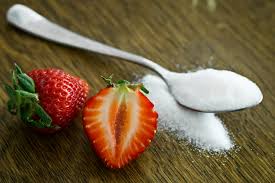What is sugar anyway?
Sugar is a type of carbohydrate and it gives you energy. Sounds good, right? Not all carbs are the same! The two types of sugar, natural and added, are very different in how they provide you with energy.
The natural sugars are what you will find in fruits, vegetables and milk. The great thing about natural sugars in the fruits and veggies is that they also have fiber, water, and nutrients. With the natural sugars, not only are you getting so much more, but because of the fiber, the sugar is released slow and steady. This means a steady stream of energy, as well as the benefits of fiber, vitamins, minerals and water. You may be wondering about fruit or vegetable juices. If the juice is 100% juice, without any added sugar, it will contain some nutrients and water, but it does not have fiber. Fiber is really the key to the slow absorption of the natural sugar and prevent sugar spikes.

Added sugars are found in many processed foods that you purchase. Of course there is added sugars in sweet treats, but it is also hiding in bread, crackers, cereals, dressings and sauces. Anything made in a factory likely has sugar added for texture, preservation and taste. Items that are labeled low fat typically have more sugar to compensate. When foods that contain added sugar enter your body it gives you a spike of sugar – your liver gets hit with an excess amount of fructose and what isn’t used for energy turns to fat. Over time, excess fat in the liver can cause Non Alcoholic Fatty Liver Disease (NAFLD), which means the liver is not functioning correctly. Too much added sugar over time is also associated diabetes, heart disease and joint pain.

How much added sugar is too much?
The FDA currently recommends added sugars be limited to 50 grams, or about 12 1/2 tsp, per day for those consuming 2,000 calories a day. The American Heart Association, on the other hand, recommends women limit themselves to 25 grams, or 6 teaspoons, of added sugars per day and men limit themselves to 38 grams, or 9 teaspoons, of added sugar per day. There is more than 9 teaspoons of added sugar in one can of a popular soda!

The FDA is now requiring food manufacturers to list the amount of added sugars on the products nutrition facts label, but they have until 2021 to make the changes. By having the information consumers will be able to gauge their added sugar intake and make choices based on the information.
Do you want to learn more?
You may be wondering about all the different names of sugar on food labels. Or, is honey natural or an added sugar? I know it’s not realistic to significantly change sugar habits during the holidays, so if you are in the Twin Cities, I will be holding a class all about sugar in January 2020. Watch my social media for details, Facebook: Inspired Vitality of Minnesota and Twitter: @InspiredMN. Enjoy the upcoming holidays, in moderation, and in 2020 we will tackle sugar together!

You must be logged in to post a comment.